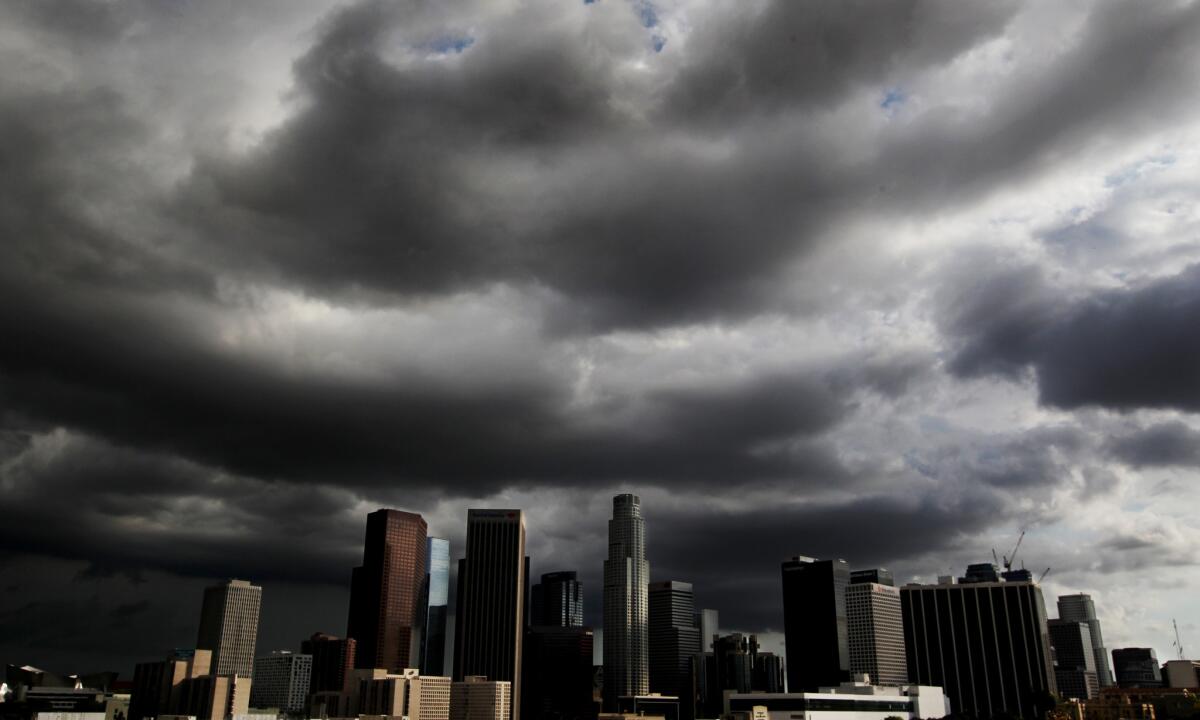California cut water use 20.3% in November; with the rain, what will happen?

Storm clouds drift over downtown Los Angeles last year. The state reduced its water use again in November, but El Niño-related rainstorms have begun this month.
- Share via
As long-awaited rain comes to the state, regulators said Tuesday that California cut its water usage by 20.3% in November, staying on track to meet the target set by Gov. Jerry Brown.
The savings percentage, compared with November 2013, was the lowest in six months of reporting and moved California’s cumulative savings to 26.3% from 27.1% in October. The November savings is still slightly above the 25% cutback that Brown called for.
Water officials have said they expect savings percentages to be lower during the colder, wetter months, when people typically use less water and there is less room to cut back.
Indeed, Felicia Marcus, chairwoman of the State Water Resources Control Board, nodded to El Niño, opening the meeting by apologizing for a late start on what she called a “gloriously gloomy day.”
“We’re in the watch-and-wait season,” Marcus said of the anticipated rain’s effect on the drought.
To cut water consumption by 25%, the water board assigned conservation standards to each of the state’s 411 urban suppliers last year.
Suppliers with a history of high per-capita water use were ordered to cut as much as 36% from 2013 totals. Suppliers with a history of lower consumption were told to cut as little as 4%.
Some have struggled to meet their targets. In November, six suppliers fell more than 15 percentage points short of their targets. Seventy-five others missed their marks by 5 to 15 percentage points, water board officials said.
The board already has penalized a few water suppliers for falling short of their mandates. Meanwhile, water board staff members said Tuesday that they continue to warn other providers that they too could face fines if they fail to improve.
Many of the hardest-hit districts have complained that their individual targets failed to take into account local conditions. So last month, state water board staff suggested changes to the rules, which prescribe how each district will contribute to the 25% statewide cut.
The effect of the modifications — which would allow regulators to consider regional climate, local growth and other factors when calculating new targets — would be to lower the state’s mandatory savings to 22%.
The relief could arrive at a crucial time for fledgling water districts. Water conservation has slipped statewide each month since July, according to the data released Tuesday.
For example, California cut its water consumption by 26.2% in September, 22.3% in October and 20.3% in November, compared with the same months in 2013.
Officials, though, remained upbeat about the state’s conservation efforts. Aided by cooler temperatures and more rain than during the same month in 2013, officials noted that Californians used about 75 gallons of water per person per day in November — the lowest average of any month since the emergency regulation took effect.
“I want to be clear that the goal post is still the 25%,” Marcus said. “We’re still winning the race. I don’t want [Californians] to be discouraged.”
Water board staff members said Tuesday that they would release an updated draft of the emergency regulation by the middle of the month after taking public comments.
The board is likely to consider adopting the updated regulation by early February, just days before the current rules expire.
“It may seem incongruous to people that we are extending the conservation regulation when we have rain falling and snow falling,” Marcus said. “But … in the spirit of ‘better to be safe than sorry,’ we’re going to need to keep going.
“We have to continue conserving until we don’t have to.”
Twitter: @ByMattStevens
Times staff writer Bettina Boxall contributed to this report.
ALSO
Heavy rains, chance of thunderstorms across Southern California
A steady conveyor belt of El Niño storms is what has officials concerned
Are you ready for El Niño? Here’s how to stay safe
More to Read
Sign up for Essential California
The most important California stories and recommendations in your inbox every morning.
You may occasionally receive promotional content from the Los Angeles Times.









